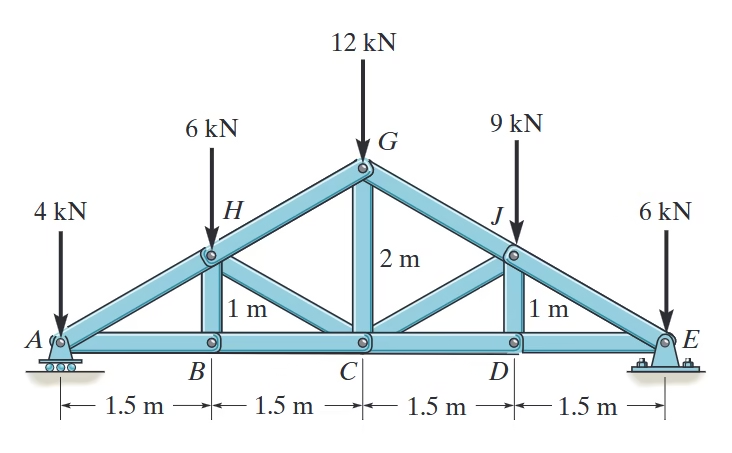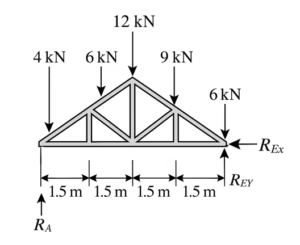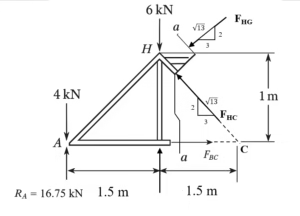$6–42$. Determine the force in members $BC$, $HC$, and $HG$. State if these members are in tension or compression

$ \text{Step by Step Solution} $
$ \text{Step 1: Given Data} $
We are tasked with determining the forces in members $BC$, $HC$, and $HG$ of the truss and identifying whether these forces are in tension (T) or compression (C).
\begin{array}{c}
\text{Forces:} \\
F_1 = 4\,\text{kN} \\
F_2 = 6\,\text{kN} \text{ at point H} \\
F_2′ = 6\,\text{kN} \text{ at point E} \\
F_3 = 9\,\text{kN} \\
F_4 = 12\,\text{kN}
\end{array}
$ \text{Step 2: Free Body Diagram} $
The free body diagram of the truss is shown below, illustrating all applied forces and support reactions.

$ \text{Step 3: Horizontal Reaction at E} $
The horizontal reaction at support E is determined by equilibrium of forces in the x-direction:
\begin{array}{c}
R_{Ex} = 0
\end{array}
$ \text{Step 4: Vertical Reactions} $
The vertical reactions are related by the equilibrium condition:
\begin{array}{c}
R_A + R_{Ey} = F_1 + F_2 + F_2′ + F_3 + F_4 \quad \text{(1)}
\end{array}
$ \text{Step 5: Moment About Point E} $
Taking moments about point E to solve for $R_A$:
\begin{array}{c}
R_A \times (6\,\text{m}) = F_1 \times (6\,\text{m}) + F_2 \times (4.5\,\text{m}) \\
+ F_3 \times (1.5\,\text{m}) + F_4 \times (3\,\text{m}) \\
R_A = \frac{F_1 \times 6 + F_2 \times 4.5 + F_3 \times 1.5 + F_4 \times 3}{6}
\end{array}
$ \text{Step 6: Calculate $R_A$} $
Substituting the given values:
\begin{array}{c}
R_A = \frac{4 \times 6 + 6 \times 4.5 + 9 \times 1.5 + 12 \times 3}{6} \\
= \frac{24 + 27 + 13.5 + 36}{6} \\
= 16.75\,\text{kN}
\end{array}
$ \text{Step 7: Calculate $R_{Ey}$} $
Using equation (1) to find $R_{Ey}$:
\begin{array}{c}
R_{Ey} = F_1 + F_2 + F_2′ + F_3 + F_4 – R_A \\
= 4 + 6 + 6 + 9 + 12 – 16.75 \\
= 20.25\,\text{kN}
\end{array}
$ \text{Step 8: Method of Sections} $
We apply the method of sections by cutting through members $HG$, $HC$, and $BC$.

$ \text{Step 9: Force in Member HG} $
Taking moments about point C to find $F_{HG}$:
\begin{array}{c}
F_{HG} \times \left(\frac{2}{\sqrt{13}}\right) \times (3\,\text{m}) = R_A \times (3\,\text{m}) \\
– F_2 \times (1.5\,\text{m}) – F_1 \times (3\,\text{m}) \\
F_{HG} = \frac{16.75 \times 3 – 6 \times 1.5 – 4 \times 3}{3} \times \left(\frac{\sqrt{13}}{2}\right) \\
= 17.6\,\text{kN (C)}
\end{array}
The positive value confirms member HG is in compression.
$ \text{Step 10: Force in Member HC} $
Taking moments about point A to find $F_{HC}$:
\begin{array}{c}
F_{HC} \times \left(\frac{2}{\sqrt{13}}\right) \times (3\,\text{m}) = F_2 \times (1.5\,\text{m}) \\
F_{HC} = 6 \times \left(\frac{\sqrt{13}}{4}\right) \\
= 5.41\,\text{kN (C)}
\end{array}
The positive value confirms member HC is in compression.
$ \text{Step 11: Force in Member BC} $
Taking moments about point H to find $F_{BC}$:
\begin{array}{c}
F_{BC} \times (1\,\text{m}) = (R_A – F_1) \times (1.5\,\text{m}) \\
= (16.75 – 4) \times 1.5 \\
= 19.1\,\text{kN (T)}
\end{array}
The positive value confirms member BC is in tension.
$ \text{Conclusion} $
\begin{array}{ll}
\text{Member HG:} & 17.6\,\text{kN in compression (C)} \\
\text{Member HC:} & 5.41\,\text{kN in compression (C)} \\
\text{Member BC:} & 19.1\,\text{kN in tension (T)}
\end{array}

Leave a reply